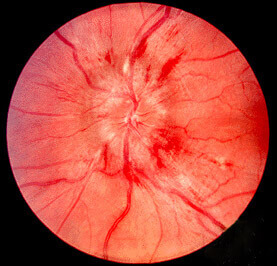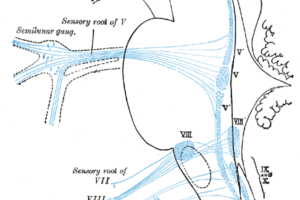
Pseudotumor cerebri, more correctly termed idiopathic intracranial hypertension (IIH), typically presents with headaches, transient visual obscurations, and pulsatile tinnitus.
The image shows optic disc swelling, commonly called “papilledema.” This is a sign of increased intracranial pressure and presents with headaches and if chronic produces enlarged blind spots.

Image attribution: “Papilledema” by Jonathan Trobe, M.D. – University of Michigan Kellogg Eye Center – The Eyes Have It. Licensed under Creative Commons Attribution 3.0 via Wikimedia Commons.
The differential diagnosis for papilledema includes anything that increase intracranial pressure, including an intracranial mass, hydrocephalus, or idiopathic intracranial hypertension (AKA pseudotumor cerebri).
IIH (pseudtumor) occurs most frequently, but not exclusively, in young, overweight females. It is often precipitated by recent weight gain, and there is an association with use of birth control pills, vitamin A, antibiotics in the tetracycline family, and cessation of steroids.
Diagnosis requires normal brain imaging (there are subtle but inconsistent MRI signs sometimes suggestive of pseudotumor, but there should be no intracranial masses or hydrocephalus) and a lumbar puncture to measure opening pressure (positive if greater that 25 cm of H2O).
Treatment includes cessation of offending medications, weight loss, therapeutic lumbar punctures with CSF removal, and inhibitors of CSF production (acetazolamide or topirimate). For medication-resistant cases CSF shunting might be required.

